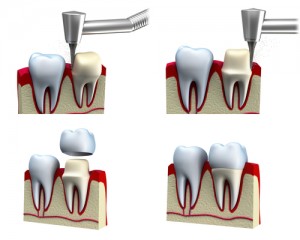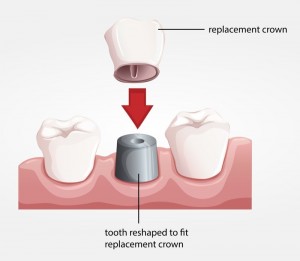Crowns: Porcelain and Metal vs. All-Porcelain Restorations
Several factors can have an impact on a patient’s choice between porcelain-fused-to-metal crowns or all-porcelain crowns for tooth restoration. These include your concern for aesthetics, whether or not you grind your teeth, and the health of your natural teeth. We’ve compared some of the main advantages and disadvantages of both options for crowns below.
All-Porcelain Crown: A tooth-like structure made entirely from porcelain. It restores the altered tooth structure and looks and functions like a natural tooth.
Porcelain-Fused-to-Metal (PFM) Crown: A metal alloy is made to fit over the altered tooth structure, and a layer of porcelain is fused to it to form a natural-looking and properly functioning tooth.
Appearance
There is no question that all-porcelain crowns look better than porcelain-fused-to-metal crowns. When porcelain crowns are handcrafted by a dental technician in a lab, the series of layers and the different shades of porcelain are what give an all-porcelain tooth its natural-looking translucency and depth of color.

The challenge of creating the same natural look with porcelain-fused-to-metal crowns is far more difficult initially because the technician must disguise the gray metal substructure beneath the porcelain. Since a layer of very opaque porcelain must be used to mask the metal, the space used for that layer minimizes how thick the outermost translucent layer of porcelain can be. However, a very natural appearance can be achieved with PFM crowns if more of the natural tooth structure can be reduced.
Another common aesthetic concern with PFM crowns is the dark line that is sometimes seen near the gumline. This dark line occurs if the gums begin to recede or if the tissue hugging the neck of the tooth is thin and translucent. In general, all-porcelain crowns are the best option for restoring teeth in the smile zone, and porcelain-fused-to-metal crowns are ideal for posterior teeth.
Durability
 Historically, porcelain-fused-to-metal crowns are more durable than all-ceramic crowns because of the strong metal layer beneath the porcelain. Currently, there have been advances using zirconia porcelain, making all-porcelain crowns a better choice all around.
Historically, porcelain-fused-to-metal crowns are more durable than all-ceramic crowns because of the strong metal layer beneath the porcelain. Currently, there have been advances using zirconia porcelain, making all-porcelain crowns a better choice all around.
Long Term Care
Both options should last an average of 10 to 15 years. Chewing ice or hard candies and severe bruxing or grinding can fracture any porcelain or natural tooth. Wearing a night guard and avoiding excessive hard foods will extend the life of all dental work. In addition, patients should visit their dentist regularly to monitor for any damage, which can be corrected.
Since every patient and tooth restoration case is unique, it takes a skilled and experienced dentist to recommend the tooth restoration option that will best meet your individual needs. If you are considering tooth restoration in the Chicago area, please schedule an appointment with Dr. Benjamin Fiss by calling (312) 642-6631. For your convenience, you may also fill out our quick contact form.